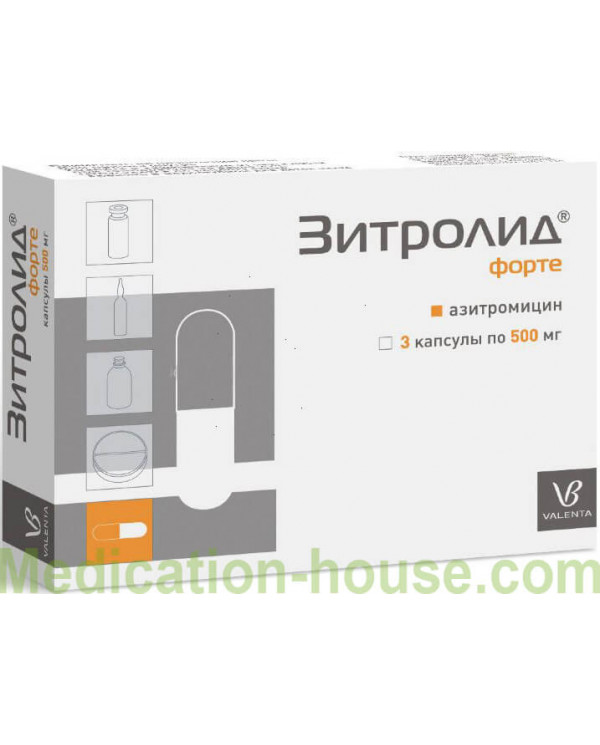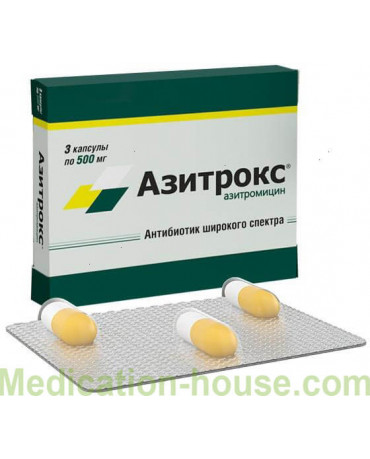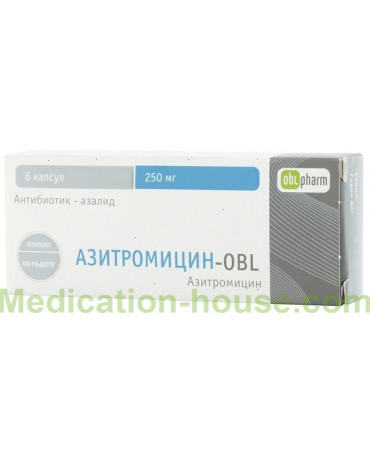Instruction for Zitrolid Forte
You can buy Zitrolid Forte here
Release form, composition and packaging
Hard gelatin capsules, size No. 00, with a white body and an orange cap; the contents of the capsules are white to white with a yellowish tinge.
1 caps
azithromycin 500 mg
Excipients: microcrystalline cellulose, magnesium stearate.
The composition of the shell: gelatin, titanium dioxide, yellow "sunset".
3 pcs. - Contour cell packages (1) - cardboard packs. 6 pcs. - Contour cell packages (1) - cardboard packs. 3 pcs. - polymer cans (1) - cardboard packs. 6 pcs. - polymer cans (1) - cardboard packs.
pharmachologic effect
The macrolide antibiotic, a representative of the azalide subgroup. It has a broad spectrum of antimicrobial action. When creating in the focus of inflammation of high concentrations has a bactericidal effect.
Zitrolid Forte is active against gram-positive cocci: Streptococcus pneumoniae, Streptococcus pyogenes, Streptococcus agalactiae, Streptococcus groups C, F and G, Streptococcus viridans, Staphylococcus aureus; Gram-negative bacteria: Haemophilus influenzae, Moraxella catarrhalis, Bordetella pertussis, Bordetella parapertussis, Legionella pneumophila, Campylobacter jejuni, Neisseria gonorrhoeae, Gardnerella vaginalis; anaerobic microorganisms: Bacteroides bivius, Clostridium perfringens, Peptostreptococcus spp.
Also active in the relationship: Chlamydia trachomatis, Mycoplasma pneumoniae, Ureaplasma urealyticum, Treponema pallidum, Borrelia burgdoferi.
Zitrolid forte is not active against gram-positive bacteria resistant to erythromycin.
Pharmacokinetics
Suction
When administered azithromycin is rapidly absorbed from the gastrointestinal tract, due to its stability in an acidic environment and lipophilicity. After taking Zitrolid Forte inside a dose of 500 mg Cmax of azithromycin in the blood plasma is achieved in 2.5-2.96 hours and is 0.4 mg / l. Bioavailability is 37%.
Distribution
Azithromycin penetrates well into the respiratory tract, organs and tissues of the urogenital tract (in particular, the prostate gland), skin and soft tissues. High tissue concentrations (10–50 times higher than in plasma) and prolonged T1 / 2 are due to the low binding of azithromycin to plasma proteins, as well as its ability to penetrate into eukaryotic cells and concentrate in a low pH environment surrounding the lysosomes. This, in turn, determines a large Vd (31.1 l / kg) and high plasma clearance. The ability of azithromycin to accumulate primarily in lysosomes is especially important for the elimination of intracellular pathogens. It has been proven that phagocytes deliver azithromycin to the sites of infection, where it is released during phagocytosis.
The concentration of azithromycin in the foci of infection is significantly higher than in healthy tissues (by an average of 24–34%) and correlates with the severity of the inflammatory process. Despite the high concentration in phagocytes, azithromycin does not significantly affect their function.
Azithromycin remains in bactericidal concentrations in the inflammatory focus for 5–7 days after the last dose, which allowed the development of short (3-day and 5-day) courses of treatment.
Metabolism
Azithromycin is demethylated in the liver to form inactive metabolites.
Removal
Removal of azithromycin from blood plasma occurs in 2 stages: T1 / 2 is 14-20 hours in the range from 8 to 24 hours after taking Zitrolid Forte and 41 hours in the range from 24 to 72 hours after taking the drug, which allows you to take it 1 time / day .
FORTE Zitrolid: DOSAGE
The drug is taken orally 1 time / day for 1 hour before meals or 2 hours after meals.
Adults with upper and lower respiratory tract infections are prescribed 500 mg / day for 3 days; course dose is 1.5 g.
With infections of the skin and soft tissues, 1 g is prescribed on the 1st day and 500 mg daily from the 2nd to the 5th day (course dose 3 g).
In acute infections of the urogenital system (uncomplicated urethritis or cervicitis), it is prescribed once for 1 year.
In Lyme disease (borreliosis), for treatment of stage I (erythema migrans), 1 g is prescribed on the 1st day and 500 mg daily from day 2 to day 5 (course dose is 3 g).
In case of gastric ulcer and duodenal ulcer associated with Helicobacter pylori, Zitrolid Forte is prescribed 1 g / day for 3 days as part of combination therapy.
For children, the drug is prescribed at the rate of 10 mg / kg of body weight 1 time / day for 3 days or on the 1st day - 10 mg / kg, then for 4 days - 5-10 mg / kg / day (course dose - 30 mg / kg).
In Lyme disease (borreliosis) for the treatment of stage I (erythema migrans), children are prescribed at a dose of 20 mg / kg on the 1st day and 10 mg / kg from the 2nd to the 5th day.
Overdose
Symptoms: severe nausea, temporary hearing loss, vomiting, diarrhea.
Drug interactions
Antacids (aluminum and magnesium), ethanol and food slow down and reduce the absorption of azithromycin.
With simultaneous administration of warfarin and azithromycin (in usual doses), no changes in the prothrombin time have been identified, however, given that the interaction of macrolides and warfarin may increase the anticoagulant effect, patients need careful control of the prothrombin time.
With simultaneous use of azithromycin with digoxin increases the concentration of the latter.
With simultaneous use of azithromycin with ergotamine and dihydroergotamine increases the toxic effect of the latter (vasospasm, dysesthesia).
With the simultaneous use of azithromycin with triazolam, the clearance decreases and the pharmacological action of the latter increases.
Azithromycin slows down and increases the concentration of , xanthine derivatives, including theophylline) due to azithromycin inhibition of microsomal oxidation in hepatocytes.
Lincosamines reduce the effectiveness of azithromycin.
Tetracycline and chloramphenicol enhance the effectiveness of azithromycin.
Azithromycin is pharmaceutically incompatible with heparin.
Pregnancy and lactation
The use of Zitrolid Forte during pregnancy is possible only in the case when the intended benefits to the mother outweigh the potential risk to the fetus.
The drug is contraindicated for use during breastfeeding. If necessary, the use of Zitrolid forte during lactation should decide on the termination of breastfeeding.
FORTE Zitrolid: SIDE EFFECTS
On the part of the digestive system: diarrhea (5%), nausea (3%), abdominal pain (3%); ≤1% - dyspepsia, flatulence, vomiting, melena, cholestatic jaundice, increased activity of hepatic transaminases; children have constipation, anorexia, gastritis.
Since the cardiovascular system: palpitations, chest pain (≤1%).
From the side of the central nervous system: dizziness, headache, drowsiness; in children - headache (with otitis media therapy), hyperkinesia, anxiety, neurosis, sleep disturbance (≤1%).
On the part of the genitourinary system: vaginal candidiasis, nephritis (≤1%).
Allergic reactions: rash, photosensitivity, angioedema; children have conjunctivitis, pruritus, urticaria.
Other: increased fatigue.
Terms and conditions of storage
Zitrolid Forte should be stored out of the reach of children, dry, protected from light, at a temperature not exceeding 25 ° C. Shelf life - 3 years.
Indications
Infectious and inflammatory diseases caused by microorganisms sensitive to the drug:
infections of the upper respiratory tract and ENT organs (angina,
pharyngitis,
sinusitis,
tonsillitis,
otitis media);
infections of the lower respiratory tract (bacterial and atypical pneumonia,
bronchitis);
scarlet fever;
infections of the skin and soft tissues (erysipelas,
impetigo,
secondary infected dermatosis);
infections of the genitourinary system (uncomplicated urethritis and / or cervicitis);
Lyme disease (borreliosis) - for the treatment of the initial stage (erythema migrans);
diseases of the stomach and duodenum
associated with Helicobacter pylori (as part of combination therapy).
Contraindications
severe liver failure;
severe renal failure;
breastfeeding period;
children up to 12 years;
hypersensitivity to Zitrolid Forte;
hypersensitivity to other macrolides.
The drug is used with caution during pregnancy, arrhythmias (possibly development of ventricular arrhythmias, prolongation of the QT interval) in children with severe impaired liver function or kidney.
special instructions
It is necessary to observe a break of 2 hours with simultaneous use of azithromycin with antacids.
After discontinuation of Zitrolid Forte, hypersensitivity reactions may persist in some patients, which requires specific therapy under medical supervision.
Use in violation of kidney function
With caution should use the drug in children with severe impaired renal function.
Zitrolid Forte is contraindicated in severe renal failure.
Use in violation of the liver
With caution should use the drug in children with severe impaired liver function.
The drug is contraindicated in severe liver failure.
Terms of sell
You don't need a prescription to buy Zitrolid Forte.




